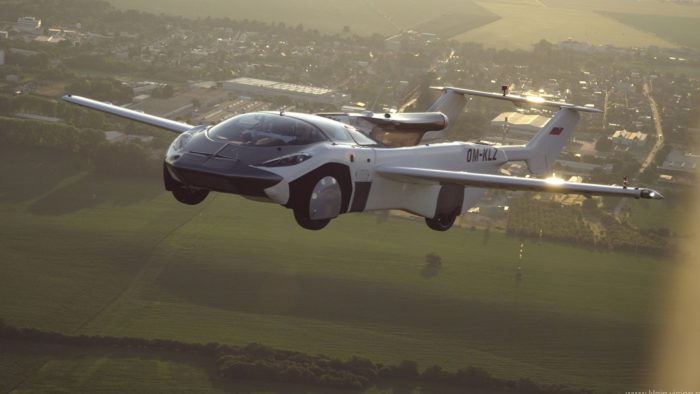“The personal-transport revolution is definitely coming but not really looking like this. From a transport point of view, it has a niche – although, a very interesting niche.”
Exactly, this will be a niche market at best, like the Segway. There isn’t going to be an AirCar in every garage. At this point, actually, the real question is – is there any niche for this vehicle beyond an expensive toy? That remains to be seen. I don’t think there is going to be much of a market to own these vehicles personally, again beyond a few of the wealthy looking for an expensive novelty. The core question, it seems to me, is what is the real advantage here? Since you have to drive to an airport to take off, what is the advantage of the AirCar over simply driving a car to an airport and then getting in a plane? I suppose the small advantage would be that you would not have to change vehicles, or have a car waiting at your destination. But for that advantage you have a vehicle that is not a great car or a great plane.
The company is positioning the vehicle as a service, to serve the medium range market. For example, they are eyeing a Paris to London route. That service could look like, being picked up at your origin, driven to a dedicated airstrip (where the gas tank is topped off), flying to another dedicated airstrip near you destination, and then driving to your final destination. This would depend on building some infrastructure (the dedicated airstrips) to avoid using existing airports and therefore avoid delays. Although, some very small local airports may serve well. Passengers are limited to three, and it does not look like there is much room for luggage. This could serve a corporate niche, if a few executives need to make a day trip to a nearby city where driving would take too long and flying would be too cumbersome. Is there going to be a sweet-spot of cost and convenience here? I would not be optimistic, but it’s not impossible.
I also agree with Wright that this is not what the personal-transport revolution will look like. If there is going to be one, then that would take a real flying car, one that can take off vertically and take you directly to your destination. In sci-fi futures, such vehicles usually essentially levitate, using some kind of anti-gravity. While this would be ideal, it is probably not allowed for by physics, and for sure is not happening anytime soon. The only realistic option for a true flying car, then, is a drone that uses blades. Drone technology has advanced considerably, to the point that onboard computers can keep them level and make them easy to fly.
As I discussed before, one main problem with the flying drone car is efficiency. It simply takes a lot more energy to get off the ground than it does to roll over it. But, when you crunch the numbers a flying car can be energy and cost efficient in the right circumstance. Mostly this means flying over congested traffic or geographical barriers. The technology seems to be getting close – essentially this mostly means just scaling up existing drones. Electric vehicle technology is already adequate, and only getting better. From my reading it seems we will have some working versions of drone cars by the end of the decade, but it will probably take another 10-20 years before the technology really matures.
And again the question becomes, will there be a profitable niche to bootstrap the drone car industry to the point of mass production and then personal use, or at least extensive use? This seems plausible, depending on cost. If you could turn a 2 hour commute into a 20 minute commute for the cost of an Uber service, then I can envision a pretty large market. A related question is – will use become large enough to provoke the creation of infrastructure to support expanded use? Once you get into that feedback loop, then the technology will (ahem) take off.
If I had to predict, I would say the flying car hybrid like AirCar will always remains a niche, at best, and likely will never be anything but a novelty. Meanwhile, drone cars are inevitable and are only a question of timing and how extensively they will be used. I know it feels like the flying car is a technology that is 20 years away, and always will be, but the technology underlying drones is a gamechanger that makes a flying car actually plausible. Often it takes much longer for new technologies to come to fruition than is initially imagined, but that does not mean they will never come.
 Research into conspiracy beliefs reveals that there are basically two kinds of people who believe in conspiracies. One type is the dedicated conspiracy theorist. For them, the conspiracy is what they are interested in. They never met a conspiracy theory they didn’t like, and they believe pretty much all of them. It’s part of their cognitive makeup. Others, however, are opportunistic conspiracy theorists – they believe one or two conspiracies that align with their ideology or tribe. Rosie O-Donnell is a 9/11 truther probably because it aligns with her politics. (As and aside, I can’t help thinking of her “fire melt steel” quote every time I see someone burn their steel on Forged in Fire.)
Research into conspiracy beliefs reveals that there are basically two kinds of people who believe in conspiracies. One type is the dedicated conspiracy theorist. For them, the conspiracy is what they are interested in. They never met a conspiracy theory they didn’t like, and they believe pretty much all of them. It’s part of their cognitive makeup. Others, however, are opportunistic conspiracy theorists – they believe one or two conspiracies that align with their ideology or tribe. Rosie O-Donnell is a 9/11 truther probably because it aligns with her politics. (As and aside, I can’t help thinking of her “fire melt steel” quote every time I see someone burn their steel on Forged in Fire.)
 In “The Future” we will have flying cars. Or so we have been promised since there were cars. The flying car is an almost ubiquitous element of visions of the future, whenever that future is. I have been seeing prototype flying cars on TV since I was a child, with reporters breathlessly touting how soon we might have one in every garage. And yet this promise remains elusive.
In “The Future” we will have flying cars. Or so we have been promised since there were cars. The flying car is an almost ubiquitous element of visions of the future, whenever that future is. I have been seeing prototype flying cars on TV since I was a child, with reporters breathlessly touting how soon we might have one in every garage. And yet this promise remains elusive. It seems
It seems  One of the frustrating things I encounter as a practicing physician is listening to patients describe how they are motivated to improve their health, and then list all the things they are doing, none of which will improve their health. I am eating organic, taking probiotics, taking supplements, and “eating clean.” They may go into detail about their “paleo” diet, some specific megavitamin or superfood, or list the herbal supplements they think will supercharge some aspect of their health.
One of the frustrating things I encounter as a practicing physician is listening to patients describe how they are motivated to improve their health, and then list all the things they are doing, none of which will improve their health. I am eating organic, taking probiotics, taking supplements, and “eating clean.” They may go into detail about their “paleo” diet, some specific megavitamin or superfood, or list the herbal supplements they think will supercharge some aspect of their health. What do you call it when you are both excited and pessimistic about something at the same time? Well whatever the word is, that’s what I feel now.
What do you call it when you are both excited and pessimistic about something at the same time? Well whatever the word is, that’s what I feel now.  It’s fun and interesting to look back over the last decade and think about what has happened and how far we have come. Round years are arbitrary, but it’s a sufficient trigger to take stock and hopefully gain some perspective on the medium course of history. There is a lot to say about the 2010s, and I may take the opportunity to say more, but I want to discuss in this essay what is perhaps our greatest challenge and disappointment over the last decade. In many ways this has been a lost decade for climate change mitigation.
It’s fun and interesting to look back over the last decade and think about what has happened and how far we have come. Round years are arbitrary, but it’s a sufficient trigger to take stock and hopefully gain some perspective on the medium course of history. There is a lot to say about the 2010s, and I may take the opportunity to say more, but I want to discuss in this essay what is perhaps our greatest challenge and disappointment over the last decade. In many ways this has been a lost decade for climate change mitigation. For the next two weeks I will be traveling to New Zealand and Australia to attend two skeptical conferences:
For the next two weeks I will be traveling to New Zealand and Australia to attend two skeptical conferences:
 There is plenty of fraud and corruption in the world, even in the halls of science. No one has a monopoly. But there are some hot spots that deserve specific attention. Recently significant concerns have been raised about the published research of Xuetao Cao, a Chinese Immunologist. This story is newsworthy because Cao is not just any immunologist – he is also the President of Nankai University, in Tianjin, China. But more to the point – he is the Chairman of research integrity in all Chinese research. When your head of research integrity is exposed for massive scientific fraud, you have a problem.
There is plenty of fraud and corruption in the world, even in the halls of science. No one has a monopoly. But there are some hot spots that deserve specific attention. Recently significant concerns have been raised about the published research of Xuetao Cao, a Chinese Immunologist. This story is newsworthy because Cao is not just any immunologist – he is also the President of Nankai University, in Tianjin, China. But more to the point – he is the Chairman of research integrity in all Chinese research. When your head of research integrity is exposed for massive scientific fraud, you have a problem. There is an interesting article over at
There is an interesting article over at 




